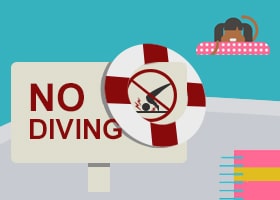 Whether you are well into your nursing career or are just beginning a job in medical assisting, it’s important to constantly be aware of your body language when interacting with patients. While what you say is certainly important, sometimes how you say it can be just as crucial when you are trying to display empathy and show patients that you truly care and want to help. The next time you talk with patients, use these body language tips to improve your communication:
Whether you are well into your nursing career or are just beginning a job in medical assisting, it’s important to constantly be aware of your body language when interacting with patients. While what you say is certainly important, sometimes how you say it can be just as crucial when you are trying to display empathy and show patients that you truly care and want to help. The next time you talk with patients, use these body language tips to improve your communication:
Don’t take a domineering stance
When patients are sitting or lying down, standing up while you talk with them can seem intimidating, which can deter them from communicating openly. Instead, get down to their level by pulling up a chair and sitting next to the patient. Encourage him or her to ask any questions he or she may have while you are talking, make eye contact and smile. To maintain an air of authority, you can use palm-down hand gestures to emphasize your points.1
Be an active listener
An effective way to engage patients in conversation is by using body language that demonstrates that you are an active listener. This is accomplished by maintaining eye contact, turning your torso toward the patient and nodding. Of course, you also have to listen to what he or she is saying and respond accordingly. This will establish an important connection of trust between you and the patient and will help facilitate better communication.2
Show professionalism
While it’s important to appear approachable, you also need to use body language that indicates a certain level of professionalism and expertise. This means never sitting in a nonchalant manner or rolling your eyes. In addition, make sure that you do not infringe upon the patient’s personal space. In other words, don’t sit on the patient’s bed while you explain his or her diagnosis.3
Look away occasionally
X-rays and patient charts not only provide valuable information, but can also be helpful when you have to deliver bad news. While it’s important to maintain eye contact while speaking, you can look at a patient’s chart to momentarily break eye contact when he or she needs a minute to let things sink in. Holding eye contact the entire time can be overwhelming, and looking away gives the patient a second to compose his or herself without feeling embarrassed.4 1 Sayler, Sharon, Scrubs Magazine, ‘3 body language tips every nurse should know,’ July 29, 2013 – Coogler, Carlson, Nursing Times, ‘You body’s talking: Molding your body language into a confident you,’ May 28, 2012 – http://www.nursingtimes.net/nursing-practice/leadership/your-bodys-talking-moulding-your-body-language-into-a-confident-you/5045146.article 3 Ward, Jennifer, Nurse Together, ‘Body Langugae in Nursing,’ March 28, 2012 – http://www.nursetogether.com/body-language-in-nursing 4 Sayler, Sharon, Scrubs Magazine, ‘3 body language tips every nurse should know,’ July 29, 2013 – http://scrubsmag.com/3-body-language-tips-every-nurse-should-know/



